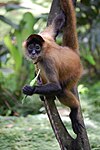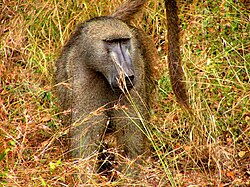The Primates Portal A primate is a member of the biological order Primates, the group that contains lemurs, the aye-aye, lorisids, galagos, tarsiers, monkeys, and apes, with the last category including great apes. With the exception of humans, who inhabit every continent on Earth, most primates live in tropical or subtropical regions of the Americas, Africa and Asia. Primates range in size from the 30-gram (1 oz) pygmy mouse lemur to the 200-kilogram (440 lb) mountain gorilla. According to fossil evidence, the primitive ancestors of primates may have existed in the late Cretaceous period around 65 mya (million years ago), and the oldest known primate is the Late Paleocene Plesiadapis, c. 55–58 mya. Molecular clock studies suggest that the primate branch may be even older, originating in the mid-Cretaceous period around 85 mya. Primates exhibit a wide range of characteristics. Some primates do not live primarily in trees, but all species possess adaptations for climbing trees. Locomotion techniques used include leaping from tree to tree, walking on two or four limbs, knuckle-walking, and swinging between branches of trees (known as brachiation). Primates are characterized by their large brains relative to other mammals. These features are most significant in monkeys and apes, and noticeably less so in lorises and lemurs. Many species are sexually dimorphic, which means males and females have different physical traits, including body mass, canine tooth size, and coloration.
Selected article
Orangutans are the two exclusively Asian species of extant great apes. Native to Indonesia and Malaysia, orangutans are currently found only in the rainforests of Borneo and Sumatra. Classified in the genus Pongo, orangutans were considered to be one species. However, since 1996, they were divided into two species: the Bornean orangutan (P. pygmaeus) and the Sumatran orangutan (P. abelii). In addition, the Bornean species is divided into three subspecies. The orangutans are also the only surviving species of the subfamily Ponginae. Both species had their genomes sequenced and they appear to have diverged around 400,000 years ago. Orangutans diverged from the rest of the great apes approximately 15.7 to 19.3 mya (million years ago).
Orangutans are the most arboreal great apes and spend most of their time in trees. Their hair is typically reddish-brown, instead of the brown or black hair typical of chimpanzees and gorillas. Males and females differ in size and appearance. Dominant adult males have distinctive cheek pads and produce long calls that attract females and intimidate rivals. Younger males do not have these characteristics and resemble adult females. Orangutans are the most solitary of the great apes, with social bonds occurring primarily between mothers and their dependent offspring, who stay together for the first two years. Fruit is the most important component of an orangutan's diet, however, the apes will also eat vegetation, bark, honey, insects and even bird eggs. They can live over 30 years. Orangutans are among the most intelligent primates and use a variety of sophisticated tools, also constructing elaborate sleeping nests each night from branches and foliage. Both orangutan species are considered to be Endangered with the Sumatran orangutan being Critically Endangered. Threats to wild orangutan populations include poaching, habitat destruction and the illegal pet trade. Selected picture Emperor tamarins inhabit tropical rain forests, living deep in the forest and also in open tree-covered areas. This diurnal species walks or runs quadrupedally through the forest, spending the majority of its days in the trees with quick, safe movements and broad jumps among the limbs. CategoriesSelected species Least Concern (IUCN 3.1)|Least Concern The chacma baboon (Papio ursinus), also known as the Cape baboon, is from the Old World monkey family. It is one of the largest of all monkeys. Found primarily in southern Africa, the chacma baboon has a wide variety of social behaviors, including a dominance hierarchy, collective foraging, adoption of young by females, and friendship pairings. These behaviors form parts of a complex evolutionary ecology. In general the species is not threatened, but human population pressure has increased contact between humans and baboons. Hunting, accidents and trapping kill or remove many baboons from the wild. This has reduced baboon numbers and disrupted their social structure. Did you know?
Primate lists
WikiProjectsThings to do
Associated WikimediaDiscover Wikipedia using portals |
















